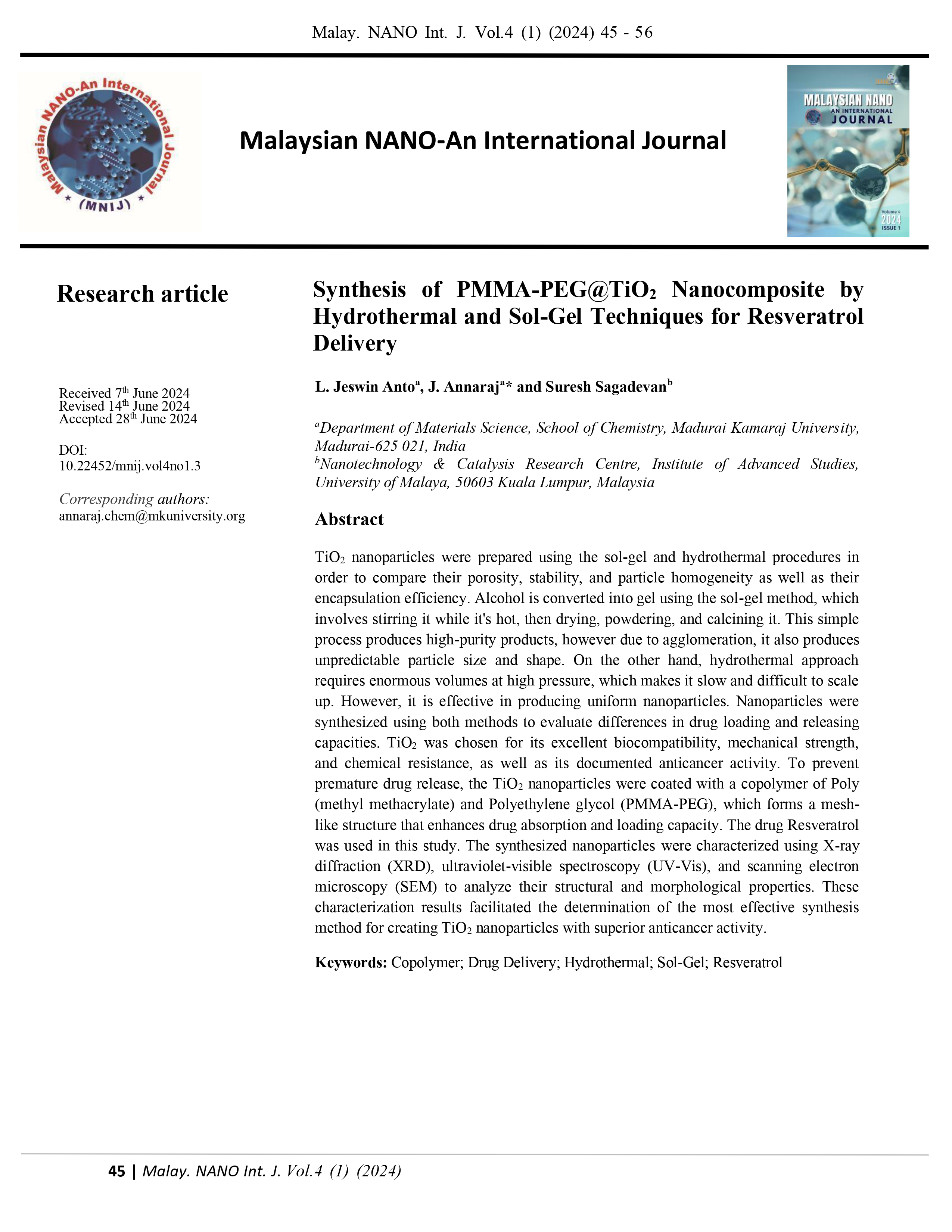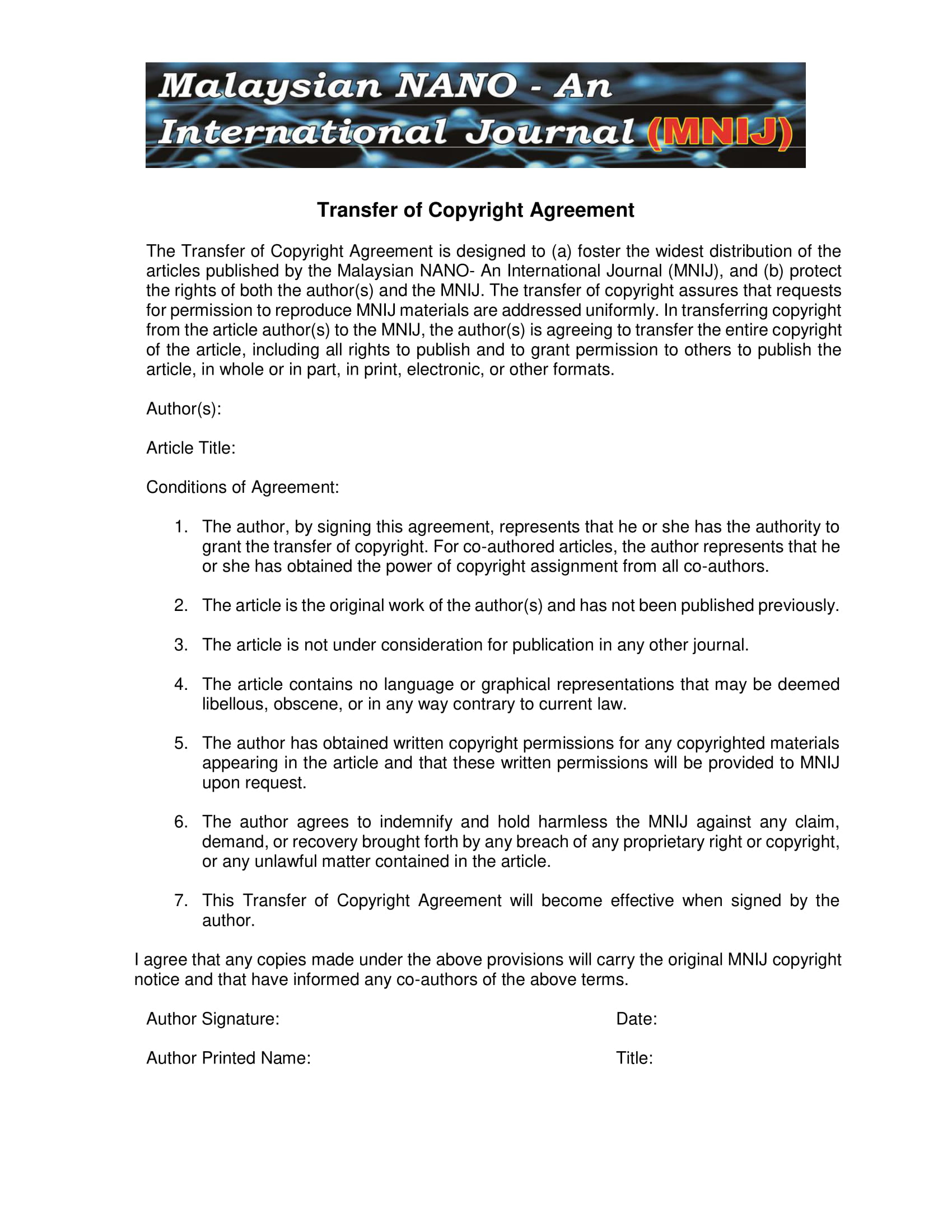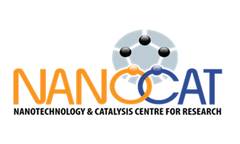Synthesis of PMMA-PEG@TiO2 nanocomposite by hydrothermal and sol-gel techniques for resveratrol delivery
DOI:
https://doi.org/10.22452/mnij.vol4no1.3Keywords:
Copolymer, Drug Delivery, Hydrothermal, Sol-Gel, ResveratrolAbstract
TiO2 nanoparticles were prepared using the sol-gel and hydrothermal procedures in order to compare their porosity, stability, and particle homogeneity as well as their encapsulation efficiency. Alcohol is converted into gel using the sol-gel method, which involves stirring it while it's hot, then drying, powdering, and calcining it. This simple process produces high-purity products, however due to agglomeration, it also produces unpredictable particle size and shape. On the other hand, hydrothermal approach requires enormous volumes at high pressure, which makes it slow and difficult to scale up. However, it is effective in producing uniform nanoparticles. Nanoparticles were synthesized using both methods to evaluate differences in drug loading and releasing capacities. TiO2 was chosen for its excellent biocompatibility, mechanical strength, and chemical resistance, as well as its documented anticancer activity. To prevent premature drug release, the TiO2 nanoparticles were coated with a copolymer of Poly(methyl methacrylate) and Polyethylene glycol (PMMA-PEG), which forms a mesh-like structure that enhances drug absorption and loading capacity. The drug Resveratrol was used in this study. The synthesized nanoparticles were characterized using X-ray diffraction (XRD), ultraviolet-visible spectroscopy (UV-Vis), and scanning electron microscopy (SEM) to analyze their structural and morphological properties. These characterization results facilitated the determination of the most effective synthesis method for creating TiO2 nanoparticles with superior anticancer activity.
Downloads
References
R. Kumar, K. Mondal, P.K. Panda, A. Kaushik, R. Abolhassani, R. Ahuja, H.-G. Rubahn, Y.K. Mishra, Core-shell nanostructures: perspectives towards drug delivery applications, J Mater Chem B (2020). https://doi.org/10.1039/d0tb01559h.
R. Hayes, A. Ahmed, T. Edge, H. Zhang, Core–shell particles: Preparation, fundamentals and applications in high performance liquid chromatography, Journal of Chromatography A 1357 (2014) 36–52. https://doi.org/10.1016/j.chroma.2014.05.010.
F.M. Galogahi, Y. Zhu, H. An, N.-T. Nguyen, Core-shell microparticles: Generation approaches and applications, Journal of Science: Advanced Materials and Devices 5 (2020) 417–435. https://doi.org/10.1016/j.jsamd.2020.09.001.
C. for D.E. and Research, Novel Drug Approvals for 2024, FDA (2024). https://www.fda.gov/drugs/novel-drug-approvals-fda/novel-drug-approvals-2024 (accessed May 23, 2024).
P.G. Jamkhande, N.W. Ghule, A.H. Bamer, M.G. Kalaskar, Metal nanoparticles synthesis: An overview on methods of preparation, advantages and disadvantages, and applications, Journal of Drug Delivery Science and Technology 53 (2019) 101174. https://doi.org/10.1016/j.jddst.2019.101174.
R. Dhivya, J. Ranjani, P.K. Bowen, J. Rajendhran, J. Mayandi, J. Annaraj, Biocompatible curcumin loaded PMMA-PEG/ZnO nanocomposite induce apoptosis and cytotoxicity in human gastric cancer cells, Materials Science and Engineering: C 80 (2017) 59–68. https://doi.org/10.1016/j.msec.2017.05.128.
J. Avossa, G. Herwig, C. Toncelli, F. Itel, R.M. Rossi, Electrospinning based on benign solvents: current definitions, implications and strategies, Green Chem. 24 (2022) 2347–2375. https://doi.org/10.1039/D1GC04252A.
J. Roy, The synthesis and applications of TiO2 nanoparticles derived from phytochemical sources, Journal of Industrial and Engineering Chemistry 106 (2022) 1–19. https://doi.org/10.1016/j.jiec.2021.10.024.
M. Aravind, M. Amalanathan, M.S.M. Mary, Synthesis of TiO2 nanoparticles by chemical and green synthesis methods and their multifaceted properties, SN Appl. Sci. 3 (2021) 409. https://doi.org/10.1007/s42452-021-04281-5.
D. Ziental, B. Czarczynska-Goslinska, D.T. Mlynarczyk, A. Glowacka-Sobotta, B. Stanisz, T. Goslinski, L. Sobotta, Titanium Dioxide Nanoparticles: Prospects and Applications in Medicine, Nanomaterials (Basel) 10 (2020) 387. https://doi.org/10.3390/nano10020387.
E. Urnukhsaikhan, B.-E. Bold, A. Gunbileg, N. Sukhbaatar, T. Mishig-Ochir, Antibacterial activity and characteristics of silver nanoparticles biosynthesized from Carduus crispus, Sci Rep 11 (2021) 21047. https://doi.org/10.1038/s41598-021-00520-2.

Downloads
Published
How to Cite
Issue
Section
License





